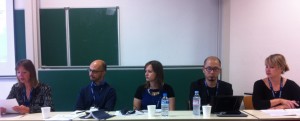During the first week of September, members of our European Research Council funded project, Carceral Archipelago, attended the Fourth European Congress on World and Global History, held in Paris at the École Normale Supérieure.
While at the Congress, a number of the project’s researchers had the exhilarating opportunity of presenting aspects of their research on a shared panel for the first time. Participants of the panel, which was titled, Carceral Archipelago: Space, circulation and penal confinement in global perspective, c. 1750-1939, felt very fortunate to have as a discussant Russianist Dr. Alain Blum of the Centre d’Études des Mondes Russe, Caucasien et Centre-Européen of des Hautes Études en Sciences Sociales.
The project’s principal investigator, Professor Clare Anderson, began the discussion with a presentation titled, A global history of penal transportation in the British Empire, c. 1750-1939. Professor Anderson described the way in which the development of penal thought within various national and colonial contexts resulted from global circulations and flows of penal knowledge. She cited multiple examples illustrative of the interconnectedness of various nations’ prison policies, the confluence of which influenced both prisoner transportation and confinement. For example, the “mark system” conceived of by British penologist Alexander Maconochie, informed the use of the “coin system” on the Andaman Islands. In a similar way, Russian legislators drew on the experiences of the French in French Guiana and the British in Australia as they struggled to reconceptualize the tsarist penal system during the mid nineteenth century. Dr. Anderson also suggested that the methods by which prisoners were documented and catalogued during the colonial era were underpinned by a sense of modernity, and can yet be seen within contemporary penal practices.
The next panelist, Dr. Christian DeVito, addressed the transportation of prisoners within the Spanish empire, with an emphasis on integrating land and sea routes, in The place of convicts in late colonial Spanish America, 1750-1830s. Dr. DeVito proposed that an overemphasis on the metropole vs. penal flows has obscured the importance of inter-regional flows of convict labour. He also foregrounded issues connected to the materiality of these transportation processes – from the ships used to convey prisoners to long land marches during which prisoners were marched, spectacle-like, through rural villages.
Panelist Katy Roscoe, a PhD student at the University of Leicester, shifted the session’s emphasis from the spatial politics of trans-oceanic passage and long prisoner marches to the individual spatiality of four British penal islands located off the coast of Australia. In Islands of incarceration: institutional and geographical diversity on Australian convict islands, Katy contrasted the varying spatial environments of Cockatoo island, Rottnest island, Melville island, and St. Helena island, drawing attention to the intersection of function and environment on each. While the over-arching goal of confinement united these locations, each was also used to answer a separate, specific need. Cockatoo island was designated as a place of secondary punishment and banishment; St. Helena island became a site for economic development. Prisoners with tickets of leave were given pistols (useful for fighting off indigenous inhabitants) and were sent to Melville island, while Rottnest island was a carceral space for indigenous offenders.
In Translation of of punishment: Integration of Japanese penal discursive sphere in the global penal information network, panelist Takashi Miyamoto discussed the circulation of European penal ideas to Japan during the late nineteenth century. Using illustrations from Bulletin de la Societe Penitentatire du Japon, he drew attention to the influence of French and British thought on Japanese legislative framers. Takashi additionally noted that the Japanese were highly incentivized to translate and study the contributions made by European nations at prison congresses throughout the late nineteenth century.
University of Leicester PhD researcher Carrie Crockett evaluated the spatiality of the tsarist penal colony on Sakhalin island, (1868-1905). Just as Pinchgut could be seen from the Sydney coast, prisoners on Sakhalin could glimpse Lazarev across the Tatar Strait. The settlement’s proximity to Siberia, which was regarded as a space ripe with opportunities for economic and social mobility, as well as to Japan, Manchuria, and China, counterbalanced Sakhalin’s reputation as a closed, brutal prison. In We could see the mainland from our shore: the blurring of spatial boundaries on Sakhalin, Carrie explored the ways in which the penal settlement’s geographical position fostered a sense of multi-national interconnectedness, the perception of which rendered its boundaries porous and negotiable.
At the conclusion of the panel presentation, Dr. Alain Blum suggested that Carceral Archipelago project researchers evaluate their papers’ overlapping themes–the spatial politics of incarceration and the circulation of ideas–with an eye to unifying them under a single context. He proposed that we consider in greater depth the ways in which spatiality might have been constructed as a result of carceral circulations. Questions from the audience also gave us much to muse upon. Dr. Judith Pallot posed the provocative question, “What makes transportation a distinctive experience?” Other scholars offered their insights regarding the impact of administrative and legal jurisdictions on prisoners’ experience of transportation.


 Subscribe to Carrie Crockett's posts
Subscribe to Carrie Crockett's posts
Recent Comments